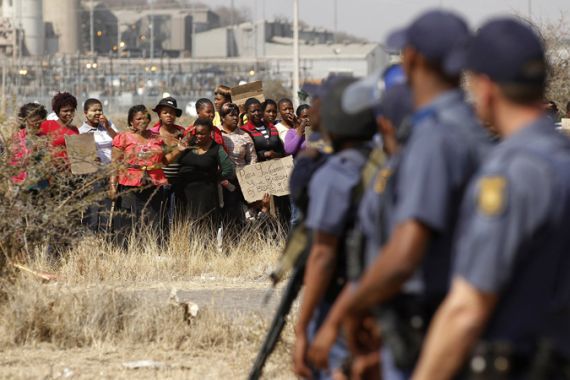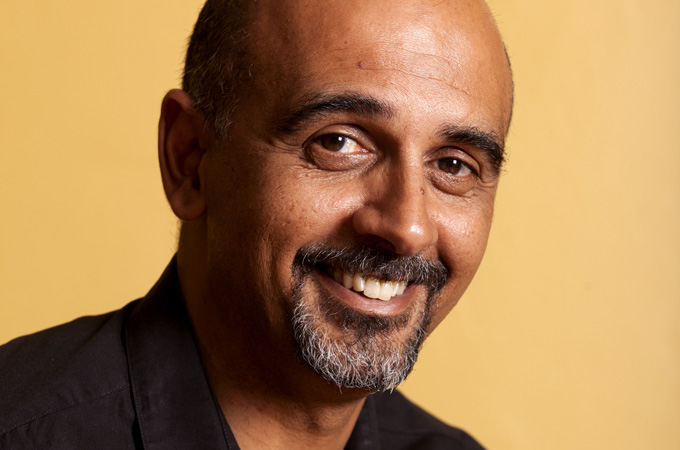Q&A: Marikana miners shot down
Filmmaker Rehad Desai speaks to Al Jazeera from Rustenburg, ahead of the second anniversary of Marikana.

Two years ago on the August 16, thousands of striking miners settled on top of a hill in Rustenburg.
Tensions were running extremely high after a violent confrontation between miners and police a few days prior left ten people dead; two policemen, two Lonmin (the holding company of the mine) security guards and six miners.
Keep reading
list of 4 itemsEurope pledges to boost aid to Sudan on unwelcome war anniversary
Birth, death, escape: Three women’s struggle through Sudan’s war
Does Israel twist humanitarian law to justify Gaza carnage?
The events that unfolded have been told and retold. By the end of the day 34 more people were dead. The police argued that the armed and aggressive miners attacked them and the gunfire that ensued was in self-defence. The miners, scattered, were arrested en masse and with some killed – their story could not be told immediately.
The film, “Miners shot down” traces the complicated and devastating chain of events leading up to what was labeled as “The Marikana Massacre”.
Filmmaker Rehad Desai spoke to Al Jazeera from the Farlam Commission of Inquiry which, two years later, is still trying to establish what went wrong on that fatal day.
Al Jazeera English: Why was it important for you to make this film?

Rehad Desai: I was actually in Marikana at the time in 2012, focusing on a story about platinum mining and whether this was advantageous or disadvantageous for the country. I was there when the strike broke out and I started covering that, thinking it would be a small element of the story … And one thing led to the other … and then we decided that we have to make this on the massacre.
Our government – that we put into power on the basis of their promises to bring a better life for all; better wages, housing, schools, clinics and so on, for the people – but in this instance, very little if anything had been delivered to the mine workers of that area.
When they did ask for a wage increase and simply demand that management speak to them, they were mowed down in a very brutal fashion, by the people who they put into power in the first place.
AJE: This week Deputy President Cyril Ramaphosa, who was a non-executive member of the Lonmin board, is giving a statement at the Farlam commission. What has it been like for you watching events unfold over the last two years?
Desai: Today I’m here at the commission, watching the evidence. It’s very tough to look at, personally, just to look Cyril in the eye.
The documentary has obviously had a huge impact in South Africa. It’s been raised today in testimony by the lawyer to the victims.
I never thought the film would occupy such an essential place in the campaign for justice. Therefore, there’s been a tremendous demand for the film because people feel genuinely disappointed that they didn’t know what the film was able to tell them, explain to them, or, most importantly, show them.
I think that the strength of this film is the immense amount of footage which was captured at the mines, in the days leading up to the massacre. To get it all into a clear picture of collusion – of a premeditated crime. I find that very disturbing.
AJE: Why is the footage shown in this film such an important part of the inquiry?
Desai: It was firstly on the events that led up to the massacre. Many people were very unclear and confused why three security guards were killed, why the policemen were killed, why a Nation Union of Mine Workers (NUM) official was killed, who killed the strikers. Once you are able to understand what happened and essentially each and every time the mine workers were shot, they were opened fire on first.
Where lives were lost on the side of the police or the security guards, it was done in self-defence, because they [the miners] were under attack, mortal attack. I mean when there are large numbers of people being shot there is going to be chaos and mayhem and lives are going to be lost.
”It
could possibly be involved in the planned murder of miners simply asking for a better wage increase”]
The official narrative was that these people [the miners] were criminals, they were suicidal, they were out killing people, that this was not a labour dispute but this was rather an unrest – that these were criminals with some hidden agenda. The footage manages to clear that up.
On the day of the actual shooting, the police narrative, which they have been hammering home for the last two years, was that they had no option but to open fire in self-defence.
And indeed they were. They had been attacked twice before they had opened fire. And these images are included in the film and were beamed around the world, of police firing. Therefore, when you put the two together along with the deaths that took place earlier, if you accept that, that story that the miners were armed and looked like they were running towards the police after the police had been attacked twice in the minutes leading up to this, then you can see. Well, this is very muddy, obviously the miners are to blame for some reason. But what the footage shows was that the police narrative was completely false.
The mine workers were leaving the mountains peacefully and had not attacked any policemen in the lead up to the police opening fire. They were on their way home, according to their own statements.
When you piece together the other evidence showing Lonmin, and the police colluding to break the strike, it all points to high-level collusion at the highest levels of political office. Which is very disturbing for people. That our own government could possibly be involved in the planned murder of miners simply asking for a better wage increase.
AJE: Cyril Ramaphosa is currently in front of the Farlam commission to give his testimony. He straddles both the ruling government, the African National Congress (ANC), as the deputy president, but was a non-executive director at Lonmin at the time of the shootings. Is there an interview with Ramaphosa in the film?
Desai: There is. I think the only interview he ever gave on this issue was to me. It’s very tough. You know I held him in high esteem for decades as a very capable and confident leader, who we had great hopes in … and now this.
AJE: What has happened to the miners? What is their situation two years down the road?
Desai: The problem is that 270 of them are still facing murder charges under the common purpose doctrine. So they are facing murder charges for the people the police shot. It’s a crazy, twisted, old-fashioned legal doctrine, which had been used very contentiously during the apartheid years, and it’s the first time it’s been used again in the new South Africa.
While this has happened, we have not seen one single police officer being charged. Which also then forces us to ask the question why? Why are political rulers not insisting these people be charged? Unless they have something to hide.
AJE: Why is it important for the international community to know what happened that day in Marikana?
Desai: It’s critical that we live in a global world. Many of us consider ourselves global citizens and we adhere to and support democratic norms.
We must never allow ourselves to forget that the South African democracy, with these killings, has been severely undermined. Because, in a democracy, governments and police cannot be used by corporations to go out and break a strike.
What makes it more severe is that they’ve done this is in a very violent, brutal manner in front of the world’s cameras and they think that they will somehow get away with it.
And that’s our fear – that no one will be brought to book. That accountability will not take place.
When these things happen, our government and our police force have to be held accountable. This has happened in a country which is hailed as a model of democracy, as a beacon of hope for other African countries where democracy isn’t as robust as ours.
If we can allow it to happen in South Africa, it will continue across Africa and across the global South as the recession bites and the corporations seek to alleviate the crisis of profitability. – Through such harsh means; through the barrel of a gun!
The Witness show, Miners Shot Down airs on Al Jazeera and is available online for a limited period.